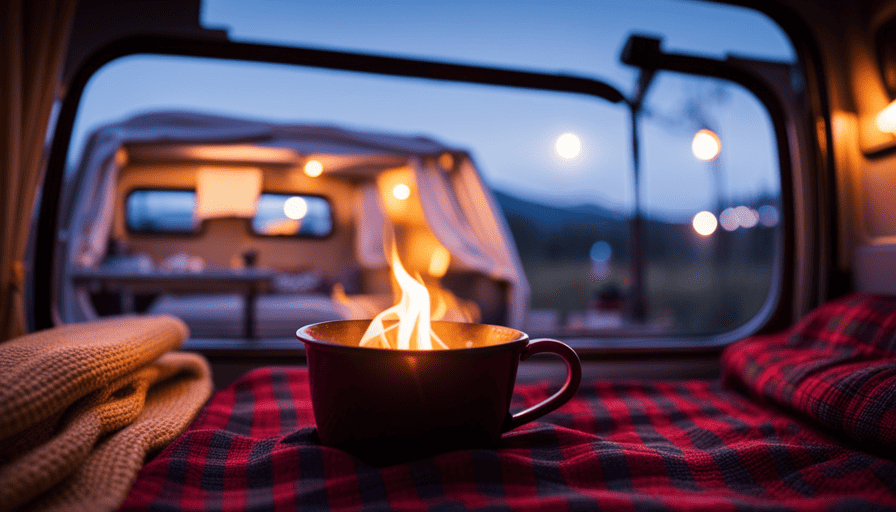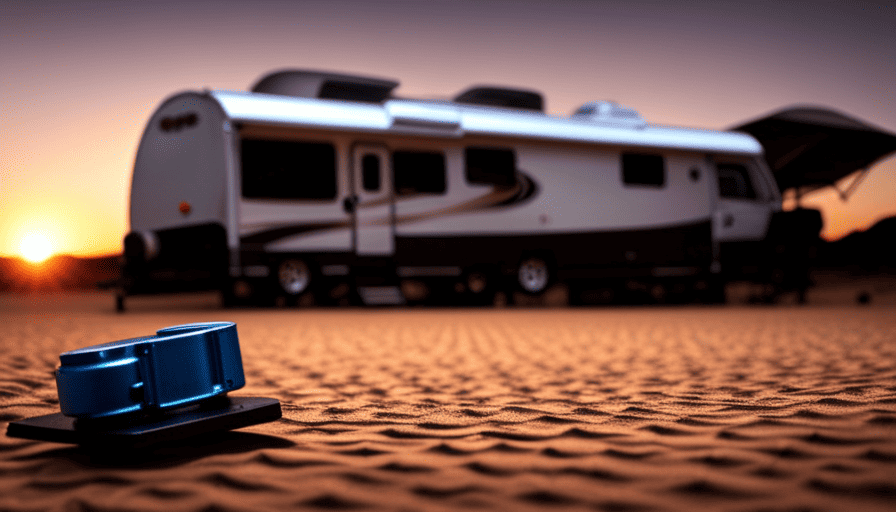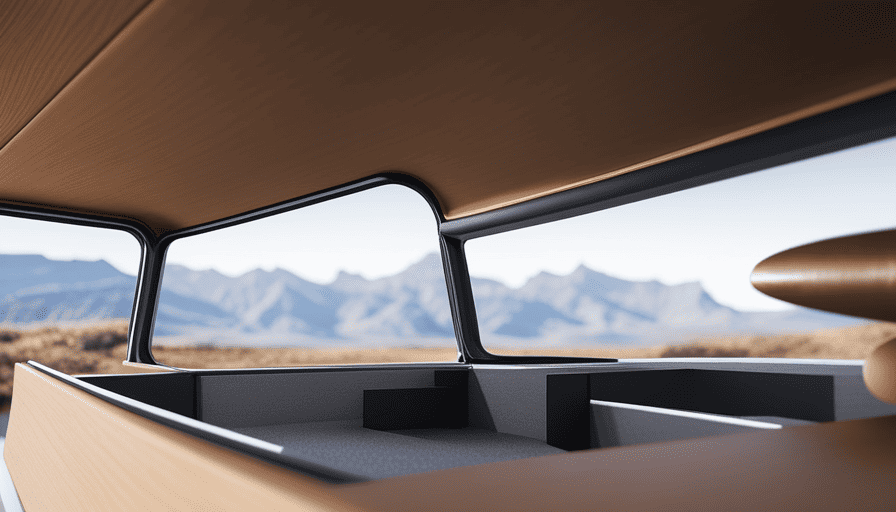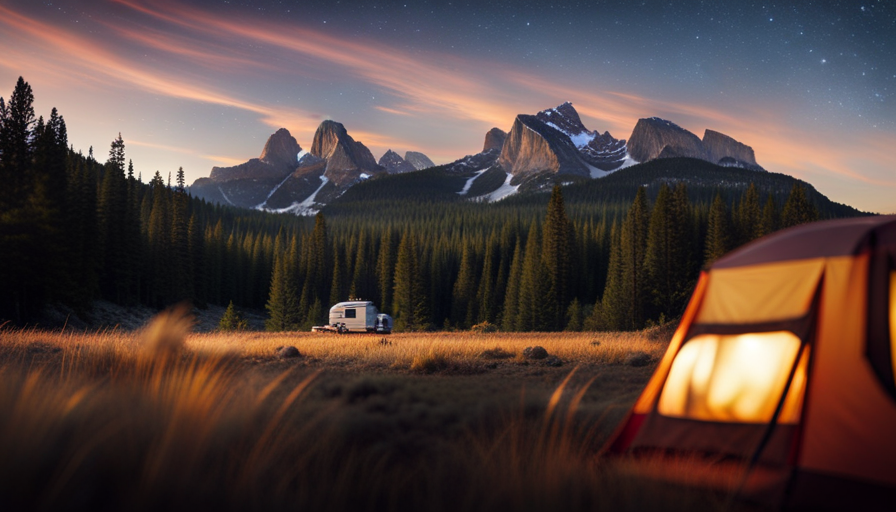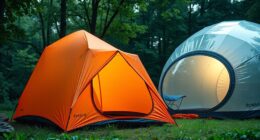Did you know that camping with a camper shell can be a warm and enjoyable experience, even in cold temperatures? With the right techniques and proper preparation, you can stay cozy and comfortable inside your camper shell, no matter how chilly it is outside.
In this article, we will share with you our top tips and tricks on how to stay warm in a camper shell. We have gathered expert advice and firsthand experiences to provide you with practical and detailed information that will make your camping adventures enjoyable, even in the winter months.
From insulating your camper shell to utilizing heating options and dressing in layers, we will cover everything you need to know to keep warm. We will also discuss the importance of proper ventilation, heat-reflective materials, staying active, staying dry, and choosing the right camping location.
So, whether you are planning a winter camping trip or just want to be prepared for unexpected cold weather, read on to learn how to stay warm in a camper shell.
Key Takeaways
- Insulating the camper shell is essential for staying warm.
- Proper bedding, such as warm blankets and sleeping bags, enhances warmth and comfort.
- Portable propane heaters and electric heaters are heating options for staying warm in a camper shell.
- Staying active through outdoor activities like hiking and walking generates body heat and helps regulate temperature.
Insulate Your Camper Shell
To ensure optimal warmth in your camper shell, it’s essential that you insulate it properly. The right insulation materials and installation process can make a big difference in keeping the cold air out and the warm air in.
There are a few options for insulation materials that work well in camper shells. One popular choice is foam board insulation, which is lightweight and easy to install. Another option is reflective insulation, which helps to reflect heat back into the camper shell.
Whichever insulation material you choose, make sure to measure and cut it to fit snugly against the walls and ceiling of your camper shell. Use adhesive or tape to secure the insulation in place, making sure there are no gaps or air leaks.
Once your camper shell is properly insulated, it’s time to think about using proper bedding to enhance your warmth and comfort. By choosing warm blankets, sleeping bags, and thermal sheets, you can create a cozy sleeping environment that will keep you warm throughout the night.
Use Proper Bedding
Ensure you have the appropriate bedding materials to create a cozy and insulated sleeping space inside your camper shell. Proper bedding is essential for staying warm and comfortable during cold nights. When choosing a mattress, opt for one that provides sufficient insulation and support. Memory foam or air mattresses are popular choices as they offer both comfort and insulation.
Additionally, consider using a mattress topper or a foam pad to provide extra warmth and cushioning.
Blankets are also crucial in creating a warm and inviting atmosphere inside your camper shell. Layering is key when it comes to blankets. Start with a warm, thick blanket as the base layer, such as a wool or fleece blanket. On top of that, add a down or synthetic-filled comforter for added warmth. To maximize insulation, tuck the blankets tightly around the edges of the mattress to prevent any drafts.
By choosing the right mattress and blankets, you can stay cozy and comfortable in your camper shell even in chilly weather. Transitioning to the next section about dressing in layers, it’s important to not only have the right bedding but also the right clothing to keep warm throughout the day.
Dress in Layers
When it’s cold outside, dressing in layers can help us maintain a comfortable body temperature throughout the day. For example, imagine you’re on a camping trip in the mountains and decide to go for a hike in the morning. By wearing multiple layers of clothing, you can easily adjust your body temperature as needed.
Here are three key items to consider when dressing in layers to stay warm while camping:
-
Base Layer: Start with a moisture-wicking base layer made of materials like merino wool or synthetic fabrics. This layer will keep you dry by wicking away sweat from your skin.
-
Insulating Layer: Add an insulating layer like a fleece or down jacket. This layer will trap heat and provide extra warmth.
-
Outer Layer: Finally, top it off with a windproof and waterproof outer layer, such as a shell jacket. This layer will protect you from the elements and keep you dry.
By choosing appropriate clothing and dressing in layers, you can stay warm and comfortable while camping. However, sometimes dressing in layers may not be enough, especially during extremely cold weather. In such cases, it’s important to utilize heating options to ensure your camper shell stays warm and cozy.
Utilize Heating Options
In order to maintain a comfortable environment during cold weather, it’s crucial to explore various heating options for your camping experience. When it comes to staying warm in a camper shell, there are a few heating alternatives to consider.
One of the most popular options is using a portable propane heater. These heaters are energy efficient and provide a significant amount of warmth.
Another option is using an electric heater, which can be plugged into a power source if available. However, it’s important to be mindful of the power consumption and ensure you have enough electricity to run the heater without draining your camper’s battery.
Additionally, utilizing insulated blankets and sleeping bags can help retain body heat and keep you warm throughout the night.
To ensure safety and proper ventilation, it’s essential to ventilate properly by cracking open a window or using a vent fan while operating any heating source. This will help prevent the buildup of carbon monoxide and maintain a healthy airflow.
By exploring these heating options and ventilating properly, you can create a cozy and warm atmosphere inside your camper shell during cold weather camping trips.
Ventilate Properly
To keep things cozy and prevent any potential hazards, it’s crucial to make sure you have proper ventilation while using heating sources in your camper. Ventilation not only benefits your overall comfort but also ensures the safety of everyone inside.
Here are two ventilation techniques that you can employ:
-
Utilize windows: Open a window slightly to allow fresh air to circulate while still maintaining warmth. This will help prevent condensation and the buildup of moisture inside the camper. Alternatively, you can install a vent fan that can be adjusted to control the airflow.
-
Use roof vents: Roof vents are an excellent option for enhancing ventilation. They can be opened and closed as needed and allow for the escape of stale air and the entry of fresh air. Additionally, some roof vents come with built-in fans that can help circulate the air more efficiently.
By implementing these ventilation techniques, you ensure a comfortable and safe environment inside your camper.
Now that you have a handle on keeping the air flowing nicely, let’s move on to another important aspect of staying warm in your camper: cooking warm meals.
Cook Warm Meals
Cooking warm meals in your camper is like adding a delicious layer of comfort to your cozy home on wheels. When you’re camping in colder temperatures, it’s important to have hearty and warming meals to keep you fueled and satisfied.
Here are some warm meal ideas that are perfect for your camper adventures.
One great option is to make soups and stews. These meals are not only easy to prepare, but they also provide a comforting and warm feeling. You can use a slow cooker or a pot on a portable stove to simmer your favorite ingredients together. Some popular choices include chili, chicken noodle soup, or vegetable stew.
Another idea is to cook meals that require baking. This not only warms up your camper, but it also fills the air with delicious aromas. You can make dishes like lasagna, casseroles, or even homemade pizzas. Just make sure to bring along the necessary baking pans and utensils.
Lastly, consider using cooking techniques that generate heat, such as grilling or frying. Grilled meats and vegetables can be a tasty and warming option. And frying foods like chicken or potatoes can add an extra layer of warmth to your meals.
Cooking warm meals in your camper is a great way to stay cozy while enjoying the great outdoors. In the next section, we’ll discuss how to use heat-reflective materials to keep the warmth inside your camper shell.
Use Heat-Reflective Materials
Utilizing heat-reflective materials is an effective strategy for enhancing the insulation within your mobile abode. When it comes to staying warm in a camper shell, heat reflective blankets and reflective insulation are essential tools. Here are five reasons why you should consider using these materials:
-
Improved heat retention: Heat reflective blankets are designed to reflect and retain heat, keeping you warm even in chilly temperatures.
-
Energy efficiency: Reflective insulation helps minimize heat loss, reducing the amount of energy required to heat your camper shell.
-
Easy installation: Both heat reflective blankets and reflective insulation are simple to install, requiring minimal effort and time.
-
Versatility: These materials can be used in various areas of your camper shell, such as windows, walls, and floors, providing comprehensive insulation coverage.
-
Lightweight and portable: Heat reflective materials are lightweight and easy to carry, making them suitable for mobile living.
In addition to using heat-reflective materials, staying active is another great way to keep warm in your camper shell. By engaging in physical activities, you generate body heat, which helps to regulate your body temperature and keep you cozy throughout the day. So let’s explore how staying active can further enhance your comfort in the next section.
Stay Active
To stay warm in a camper shell, we can stay active by engaging in outdoor activities that generate body heat. Going for a hike or walk is a great way to keep warm, as the movement gets our blood flowing and warms up our muscles.
Additionally, we can do exercises inside the camper shell, such as stretching or yoga, to stay active and generate body heat.
Engage in outdoor activities to generate body heat
Engaging in outdoor activities can help generate body heat, and did you know that a person can burn up to 300 calories per hour while hiking in cold weather? It’s a great way to stay warm while enjoying the outdoors.
Here are some ideas to help you make the most of your time outside:
-
Try outdoor sports: Activities like skiing, snowboarding, or ice skating can get your blood flowing and keep you warm. Plus, the adrenaline rush from these sports can provide an extra boost of heat.
-
Keep moving: Whether it’s playing a game of frisbee or going for a brisk walk, staying active is key to generating body heat. Remember to layer your clothing to stay comfortable as you move.
Engaging in outdoor activities not only helps generate body heat but also makes your camping experience more enjoyable. So, go for a hike or walk to keep warm and explore the beautiful surroundings.
Go for a hike or walk to keep warm
Why not hit the trails and take a leisurely hike or walk to keep ourselves cozy during those chilly outdoor adventures? Hiking not only helps to generate body heat, but it also offers numerous benefits for our overall well-being. Outdoor exercise boosts our mood, reduces stress, and improves cardiovascular health.
It allows us to connect with nature and provides a refreshing change of scenery. When hiking, make sure to dress in layers to stay warm and wear proper footwear for traction on slippery surfaces. Bring along a thermos of hot tea or soup to enjoy a warm treat while taking in the beautiful views.
So, lace up your boots and head out on a hike to stay warm and active.
Transitioning into the next section, we can also do exercises inside the camper shell to keep ourselves active.
Do exercises inside the camper shell to stay active
One interesting statistic is that indoor exercises can help improve flexibility and muscle strength. When it comes to staying warm in a camper shell, doing indoor workouts is a great way to stay active and generate some heat.
There are plenty of stretching exercises that can be done inside the camper shell to keep our bodies warm and limber. We can start with some simple stretches like neck rolls, arm circles, and leg swings. Then, we can move on to more challenging exercises like squats, lunges, and push-ups. By incorporating these indoor exercises into our routine, we not only stay warm but also maintain our fitness levels.
As we transition into the next section about staying dry, it’s important to remember that exercise is just one piece of the puzzle.
Stay Dry
To stay dry in your camper shell, make sure to bring waterproof gear and seal any potential leaks with silicone caulking. This will help keep moisture out and ensure a comfortable camping experience.
Here are some additional tips to help you stay dry:
-
Invest in a high-quality rainfly for your camper shell. This’ll provide an extra layer of protection against rain and prevent water from seeping in through the windows or vents.
-
Use moisture-absorbing products like desiccant packs or dehumidifiers to control humidity inside the camper shell. Excess moisture can lead to condensation and dampness, so it’s important to keep it under control.
-
Make sure to dry any wet items, like clothes or towels, before bringing them inside the camper shell. Wet items can introduce moisture and create a damp environment.
-
Regularly check for any signs of leaks or water damage. If you notice any, address them immediately to prevent further problems.
By following these tips, you can stay dry and comfortable in your camper shell. Now, let’s move on to the next section and learn how to plan your camping location wisely for an even better camping experience.
Plan Your Camping Location Wisely
Choose your camping location wisely to ensure a memorable and enjoyable experience. For example, imagine parking your camper shell in a secluded spot near a picturesque lake, where you can wake up to the soothing sounds of nature and spend your days exploring the surrounding hiking trails.
When it comes to staying warm in a camper shell, selecting the right camping location is crucial for both camping safety and emergency preparedness.
First and foremost, consider the climate and weather conditions of your chosen camping location. Look for areas with mild temperatures and minimal precipitation. Avoid camping in low-lying areas where cold air can settle, and instead, opt for higher ground with good airflow. This will help prevent condensation and keep the interior of your camper shell dry.
Additionally, take note of any potential hazards in the area. Look for signs of flooding, falling trees, or other dangers that could compromise your safety. It’s also a good idea to research the campground’s emergency protocols and familiarize yourself with the nearest medical facilities in case of an emergency.
Lastly, prepare for unexpected weather changes. Pack extra blankets, warm clothing, and a reliable heat source such as a portable heater or a well-insulated sleeping bag. It’s better to be over-prepared than to find yourself shivering in the middle of the night.
By choosing your camping location wisely and being prepared for any weather conditions, you can ensure a cozy and safe experience in your camper shell.
Frequently Asked Questions
Can I use a portable electric heater inside my camper shell?
Yes, we can use portable electric heaters inside a camper shell as an alternative heating method. These heaters are convenient and easy to use, and they provide a good amount of warmth. However, it’s important to consider safety precautions such as ensuring proper ventilation and keeping flammable materials away from the heater. Additionally, it’s advisable to have a backup heating method in case the electricity supply is limited or unavailable.
What are some effective ways to insulate the windows of my camper shell?
Insulating curtains and window film are both effective ways to insulate the windows of a camper shell. Insulating curtains are made from thick, thermal materials that help keep heat inside the camper shell. They can be easily installed using curtain rods or Velcro.
Window film is another option that provides insulation by reducing heat transfer through the windows. It’s a thin, transparent film that can be applied directly to the glass.
Both options are practical and provide an extra layer of insulation to keep the camper shell warm.
Are there any specific types of bedding that are better for staying warm in a camper shell?
When it comes to staying warm in a camper shell, choosing the right bedding can make all the difference.
For maximum warmth and comfort, I recommend using mattress toppers and sleeping bags specifically designed for cold weather camping. Look for mattress toppers made with insulating materials like memory foam or down feathers.
As for sleeping bags, opt for ones with a lower temperature rating to ensure you stay cozy throughout the night.
How can I ensure proper ventilation inside my camper shell without losing heat?
Proper ventilation is crucial to maintain a comfortable temperature inside a camper shell while retaining heat. To achieve this, we can install adjustable vents on the shell’s roof or side walls. These vents allow airflow control, preventing condensation and ensuring fresh air circulation.
Additionally, insulating the shell and using thermal curtains will help retain warmth. Remember, finding a balance between ventilation and heat retention is key for a cozy and healthy camper shell environment.
Are there any safety precautions I should take when using heat-reflective materials inside my camper shell?
When using heat-reflective materials inside a camper shell, it’s important to take certain safety precautions. Firstly, ensure that the materials are non-flammable and meet safety standards.
Additionally, make sure they’re properly installed and secured to avoid any accidents. It’s crucial to regularly inspect the materials for any signs of damage or wear.
Lastly, always follow the manufacturer’s instructions and guidelines for safe usage. By taking these safety precautions, you can stay warm and comfortable while minimizing the risk of accidents.
Can the Tips for Keeping a Camper Warm in Winter Also Apply to Staying Warm in a Camper Shell?
Yes, the same keeping camper warm winter tips can also apply to staying warm in a camper shell. This includes using insulation, sealing any gaps, using a portable heater, and investing in a good sleeping bag and thermal blankets to keep warm and insulated in cold weather.
Conclusion
To round it all up, staying warm in a camper shell requires some thoughtful preparation and practical know-how. By insulating your shell, using the right bedding, dressing in layers, and utilizing heating options, you can create a cozy haven on those chilly nights. To enhance your camper shell experience even further, consider implementing some camper shell building tips to maximize warmth and comfort. These may include installing reflective window coverings, sealing any cracks or gaps, and incorporating a small space heater or heated blanket. By taking these extra steps, you can ensure that your camper shell becomes the ultimate retreat for cold-weather camping adventures.
Don’t forget to ventilate properly and use heat-reflective materials for added warmth. Stay active and dry, and carefully choose your camping location to make the most of your warm and comfortable camper shell experience.
So, with these tips in mind, embrace the cold with a euphemistic warmth that’ll make your camping adventures truly memorable.

